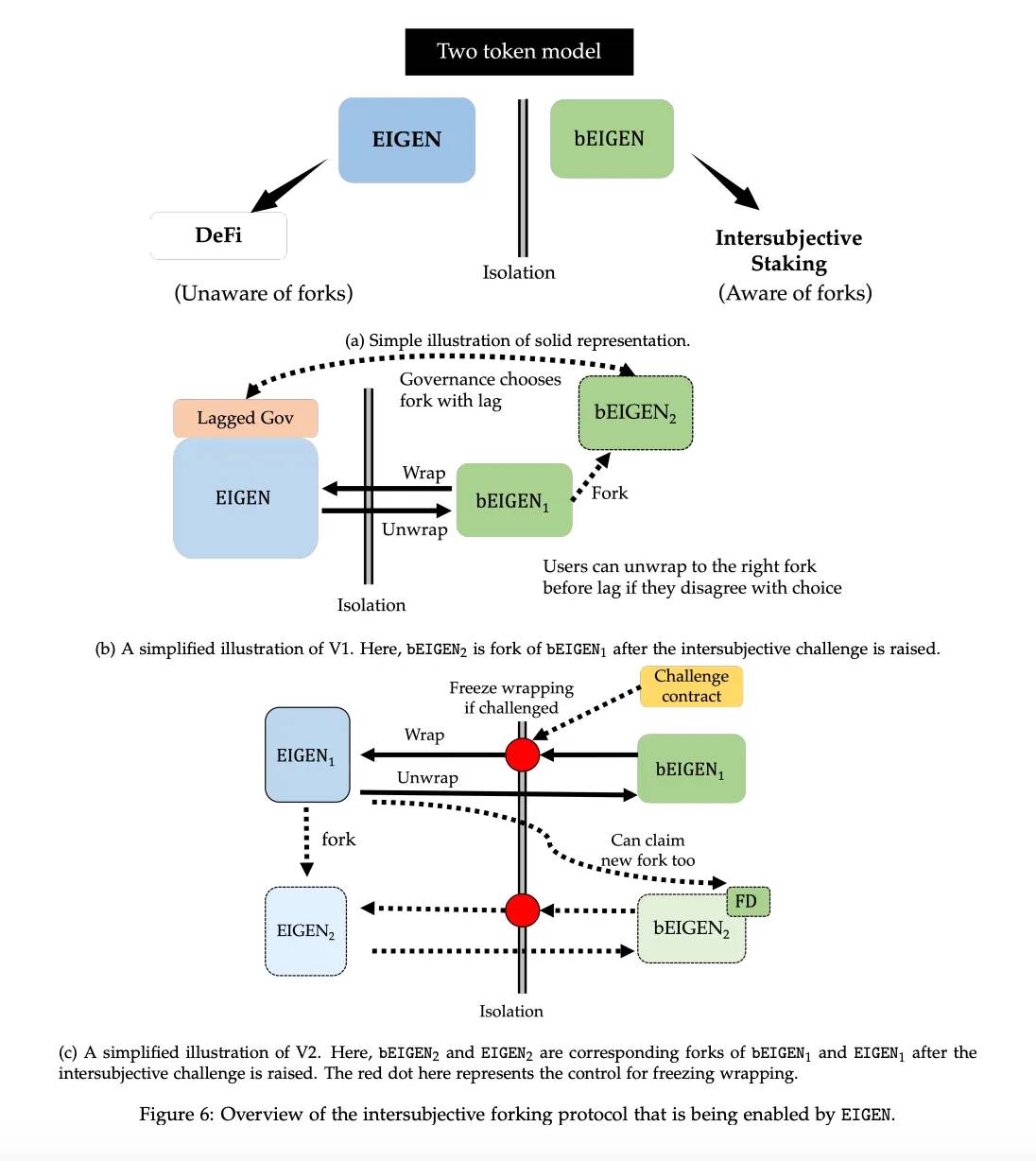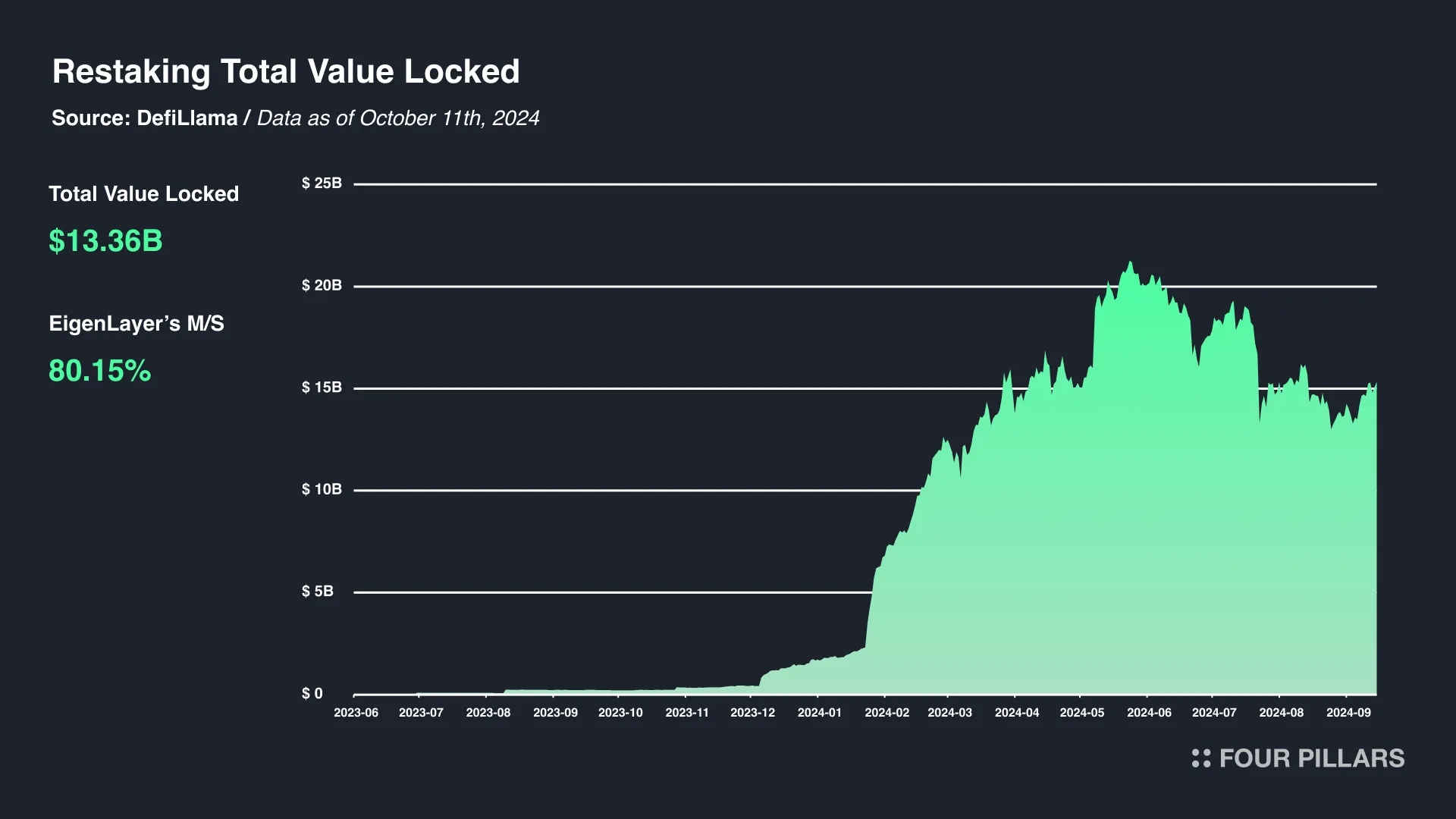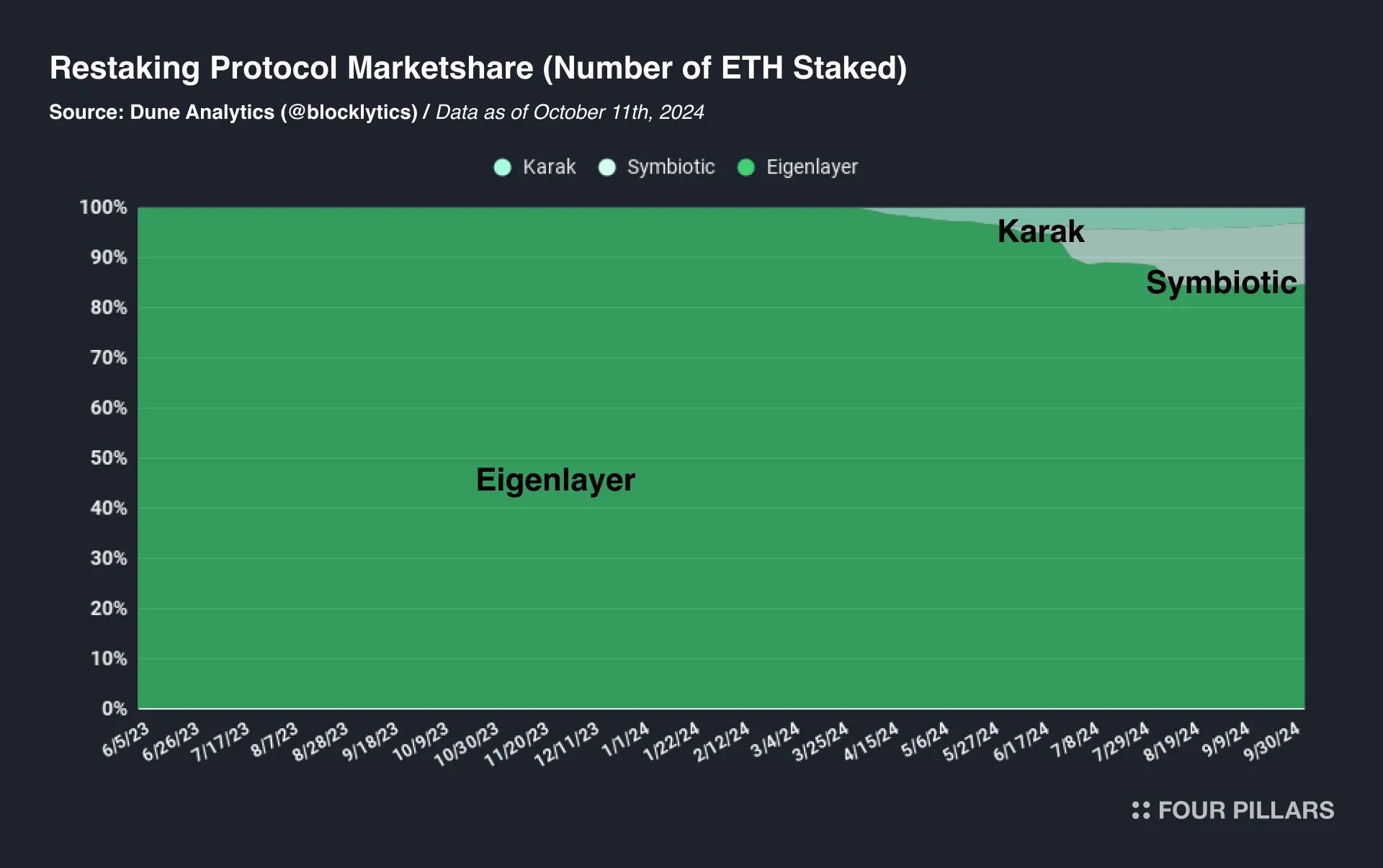This report will analyze the fundamental reasons for the poor performance of $EIGEN and explore its future prospects.
Author: Ponyo
Compiled by: Deep Tide TechFlow

Earlier this year, $EIGEN traded above $13 in the over-the-counter market, but since its listing on October 1, its price has fluctuated between $3 and $4, with a fully diluted valuation of approximately $5 billion to $7 billion. This means that EigenLayer's market value has dropped by 70% in just six months. Such a sharp decline has left investors puzzled and sparked criticism that the highly anticipated Restaking innovation has failed to meet expectations. In this report, we will analyze the fundamental reasons for the poor performance of $EIGEN and explore its future prospects.
For a detailed explanation of the concept of Restaking, please refer to the report “Restaking Stack: Classifying the Restaking Ecosystem”
- Background - Reasons for $EIGEN's Poor Performance Post-Listing ----------------------
The weak performance of $EIGEN post-listing can be primarily attributed to two key factors frequently mentioned within the community.
1.1 Ambiguity of Token Utility
In the white paper dated April 29, 2024, Eigenlayer describes $EIGEN as a "Universal Subjective Work Token." This complex and unfamiliar term makes it difficult for investors to understand the core value of the token.

Source: Youtube (@Curt Explores)
In simple terms, the primary role of $EIGEN is to mediate and resolve issues within Active Validation Services (AVS), but effectively communicating this is a challenge.
For instance, while industry insiders are well aware of this concept, the lack of direct information regarding the actual use of the token—especially for retail investors—has caused confusion. Explaining how $EIGEN addresses failures in decentralized systems adds complexity to its acceptance and understanding, particularly in a competitive narrative ecosystem. Let’s delve into the various components of this explanation.
Universal
“Universal” indicates that $EIGEN is not limited to a specific blockchain network but can be widely applied across various blockchain infrastructures and applications, such as zk-rollups, cross-chain bridges, MEV solutions, Trusted Execution Environments (TEEs), and even AGI (Artificial General Intelligence) solutions. This flexibility stems from EigenLayer's ability to handle asset staking and validation tasks across multiple networks, despite being based on Ethereum. Compared to traditional L1 tokens that are typically bound to specific blockchain ecosystems, this broad applicability of $EIGEN is its main differentiating feature.
Work Token
“Work Token” refers to tokens staked in the network to perform specific tasks. In blockchain, these tasks include validating transactions, generating proofs, and ensuring the integrity of the network—all fundamental to Proof of Stake (PoS) systems. In EigenLayer, $EIGEN and its staked version $bEIGEN support the execution of these tasks across various AVS. Validators who fail to comply with protocol rules will face economic penalties, namely the slashing and confiscation of $bEIGEN. This mechanism is similar to traditional PoS systems, but its scope of tasks is broader, extending beyond typical L1 validation to expand its application and reach in decentralized services.
Intersubjective
In the blockchain environment, failures can be categorized into three types: objective failures, subjective failures, and subjectively attributable failures. Subjectively attributable failures are particularly interesting because they cannot be verified solely through technical means, yet are widely recognized as failures by participants. These failures often arise in situations involving off-chain data or requiring human judgment, such as price data errors or censorship events. Addressing these failures relies on the collective consensus of network participants, making it central to the utility of $EIGEN. This ability to handle consensus-driven errors, especially those involving subjective data inputs, distinguishes $EIGEN from tokens focused solely on pure technical validation.

Source: EIGEN: Universal Inter-Subjective Work Token | Feature Layer
As mentioned earlier, $EIGEN serves as a mediation tool specifically designed to address subjective failures—issues that cannot be definitively judged as right or wrong through technical means but are widely recognized as errors by participants. For example, if a validator intentionally submits incorrect data or violates protocol rules, the malicious party's staked $EIGEN will be removed from the network through a forking process. Here, the fork does not merely signify a separation from the network; it serves as a powerful punitive measure that can render the value of the tokens held by the violating validator to zero.
Forking Process
When a failure is detected in a specific Active Validation Service (AVS), challengers can raise a dispute. To resolve this issue, the network will destroy the original $EIGEN and issue new forked tokens, $EIGEN2. In this process, the Fork Distributor (FD) contract allows legitimate $EIGEN holders and stakers to exchange their tokens for the new forked version, $EIGEN2. However, the staked $bEIGEN of malicious actors cannot be converted to $bEIGEN2, rendering their assets worthless.
This forking mechanism serves both as a deterrent and a protective measure, ensuring that participants who contribute to the health of the network are safeguarded, while malicious actors find their held value reduced to zero. It is a robust economic penalty mechanism designed to maintain the integrity of the network and ensure that only honest participants are rewarded.

Source: EIGEN: Universal Inter-Subjective Work Token | Feature Layer
At this point, a reasonable question arises: why not handle these failures directly with $ETH instead of relying on $EIGEN? This is because adding tasks that require subjective or intersubjective decision-making to Ethereum's consensus mechanism could overload it. Ethereum's consensus mechanism is primarily designed for tasks that can be objectively verified, such as validating transactions and ensuring the correct state of the blockchain.
However, when it comes to tasks requiring human judgment, such as determining whether a result is fair (for example, in prediction markets or content moderation), reaching consensus becomes more complex. These tasks could overload Ethereum's social consensus mechanism, as they require subjective agreement among participants, which is not as straightforward as validating cryptographic proofs. By introducing the $EIGEN token, Eigenlayer aims to shift these subjective tasks to a different consensus layer, allowing for the handling of more complex tasks requiring social consensus while preserving Ethereum's cryptoeconomic security for objectively verifiable transactions.
Overall, while the existence of $EIGEN makes sense, its utility is both apparent and somewhat ambiguous. Although theoretically, the role of $EIGEN in enhancing the security of AVS and addressing subjective failures is clear, its actual utility remains unknown to many investors. The value of this token only becomes apparent when subjective errors occur within the network, meaning that in the absence of these issues, its utility may seem less obvious. This positions $EIGEN as a niche token, contrasting sharply with meme coins that, despite lacking inherent utility, gain popularity through hype.
This point was reflected in a recent survey conducted by Pinkbrains CEO DeFiIgnas, where over 60% of respondents (2,314 out of 3,839) indicated they would prefer to invest in $MOG rather than $EIGEN. This result suggests that investors often favor assets with simple and understandable narratives, further highlighting the challenges $EIGEN faces in attracting broader attention.

Source: X (@DefiIgnas)
1.2 The Impact of Airdrop-Induced Selling Pressure
Another key reason for $EIGEN's recent poor performance is that airdrop recipients have increased selling pressure to realize profits. This phenomenon is common after the token listings of many projects. Historical data shows that many airdropped tokens face downward price pressure shortly after listing, as early holders are often eager to sell their free tokens. For example, in the past year, major projects that listed their tokens experienced significant price declines within the first 30 days post-listing. While macroeconomic conditions, valuations, and token economics all influence these price fluctuations, the impact of airdrop tokens should not be underestimated.

In the case of EigenLayer, of the initially circulating 185 million $EIGEN, as much as 46% (approximately 86 million $EIGEN) came from airdrops. These tokens included allocations to institutional investors and crypto whales such as Blockchain Capital and Galaxy Digital. Notably, it was reported that Justin Sun and GCR transferred airdropped $EIGEN worth approximately $8.75 million and $1.06 million, respectively, to centralized exchanges, further exacerbating the selling pressure. Additionally, the EigenLayer Foundation recently announced that approximately 1.67 million $EIGEN were stolen in a hacking incident, worsening the situation.
- Insights - Focus on Strong Fundamentals for AVS Ecosystem Growth -----------------------
Like any asset, price fluctuations often reflect the fundamental growth of a project in the long run. In this regard, EigenLayer's fundamentals remain solid, and the primary factor to watch for the future is the growth of its Active Validation Services (AVS) ecosystem.
2.1 Market Dominance from First-Mover Advantage

EigenLayer launched its services in June 2023, being the first to introduce the concept of restaking. Since then, inspired by this model, various innovative projects have emerged across different blockchain ecosystems. For example, Symbiotic and Karak have made significant progress in the Ethereum ecosystem, while Solayer and Jito have expanded into the Solana ecosystem. In the Bitcoin space, projects like Babylon are also exploring similar approaches. Additionally, Liquid Restaking Token (LRT) projects such as Ether.fi and Puffer.fi are being developed based on the foundational concepts introduced by EigenLayer. This wave of development highlights EigenLayer's key role in shaping a broader restaking ecosystem while fostering a collaborative and evolving environment.

Market data further confirms this dominance. As of October 11, 2024, the total value locked (TVL) in restaking protocols reached approximately $13 billion, with EigenLayer accounting for about $10 billion (equivalent to 4.5 million $ETH), capturing 80% of the market share. In contrast, Symbiotic and Karak hold market shares of 11.7% and 3.7%, respectively.

2.2 The Key is the Growth of the AVS Ecosystem
While EigenLayer maintains a leading market share, the most critical factor to watch for the future is the growth rate of its AVS ecosystem. No matter how advanced EigenLayer's technology is, its value remains limited without widespread user adoption and practical applications. If the growth of the ecosystem stagnates, EigenLayer may lose market share to emerging competitors. More importantly, the revenue generated by AVS will be directly distributed to $EIGEN stakers, meaning the success and expansion of AVS are closely tied to the value of $EIGEN.
Finally, although there is currently no clear narrative in the market to drive demand for $EIGEN, if market expectations arise for an "AVS airdrop" token similar to $TIA earlier this year, this could become a potential catalyst. Once such expectations form, the growth of the AVS ecosystem could significantly boost demand for $EIGEN. As of now, there are 17 AVS projects under development on EigenLayer, including EigenDA, with the potential for more projects to join in the future. Additionally, 44 major networks, including Abstract, MegaETH, Mantle, and Movement, have already supported or utilized EigenDA, demonstrating its expanding influence.

免责声明:本文章仅代表作者个人观点,不代表本平台的立场和观点。本文章仅供信息分享,不构成对任何人的任何投资建议。用户与作者之间的任何争议,与本平台无关。如网页中刊载的文章或图片涉及侵权,请提供相关的权利证明和身份证明发送邮件到support@aicoin.com,本平台相关工作人员将会进行核查。




